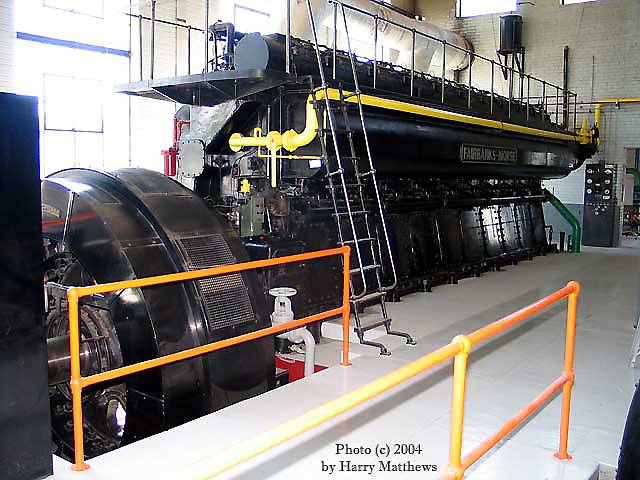Fairbanks-Morse 31AD18 Diesel Engine
By Steve McCollum; posted March 22, 2014
View Original: Click to zoom, then click to magnify (640 x 480) 50KB

|
This is a ten cylinder, 3,500 horsepower F-M 31AD18 Diesel engine and alternator. This one is located in Delta, Colorado, and is one of the few left in existence. The "31" refers to the year when this model of engine was first built. "D" means dual-fuel, oil and natural gas. The yellow pipe is the natural gas line. My previous picture of a bent marine Diesel conn rod prompted me to post this picture, too. This bad boy has an 18" bore by 27" stroke! Not huge by modern marine engine standards, but not bad. Look at the manholes on the side of the crank case! I hung out at the local light plant in Jacksonville, IL when I was in high school. They had six engines there. The largest was like this one. I could stand up full height under the exhaust manifold, and hear each cylinder blow down. There's a signature sound that these old, low-speed (277 RPM) 2-cycle Diesel engines make that isn't duplicated by any of the modern, 1800 RPM short stroke engines, like the CAT 3516. Oh, sure, the newer engines are plenty noisy, but they don't shake your soul like a large-displacement engine where each cylinder fires around 5 times per second! Speaking of sound, this engine is started and stopped on oil, but can be run on natural gas, with a tiny amount of Diesel fuel used to ignite the air-gas mixture. Through the fog of 50+ years, I can still hear that engine running. Funny - it sounded different when running on oil than it did on natural gas. It still shook your soul, but the combustion sound was more sharp, more like the crack of a whip, when running on natural gas. I saw this engine come unglued! When I walked in one fine Saturday afternoon in 1962, the chief engineer was scrambling to start a couple of other engines to pick up the load before shutting the big one down. Apparently the lube oil line that fed the rings was plugged, and it was starting to screech. The cylinder was cracked, and jacket water was flooding out. They had a number of industrial plants as customers, and didn't want to upset the plants, then have to restart all those induction motors! When he shut this engine down, it slowed to stop, then backed off about a quarter turn from whichever cylinder was under compression. BANG! A red-hot piece of ring fell into the crankcase and ignited the oil vapor. Fortunately, these guys had equipped the bolt heads for a number of the hand-holes and manholes with springs, after losing the intake manifold on another engine at startup due to a natural gas leak. So the crankcase manholes vented the over pressure. Also, the cover plate over the timing chain (look just to the left of the yellow gas line, and just above the alternator to see it) blew off and broke a bay window. Good thing nobody was standing there, or they would have gotten a face full of plexiglas and hot oil. That cover was transparent, and you could see a couple of idler sprockets that redirected the chain, plus the oil spray that was directed onto the chain, Unfortunately, they replaced that clear cover with a solid one. About a minute later, here comes a fireman, carrying a pee can extinguisher, to confront a smoking 3,500 horsepower engine. Hilarious! He was trying to figure out where to squirt the water! A couple of days later, I visited again, to find the man-hole covers removed and the guys replacing the power unit – piston, cylinder, and head. I got to climb inside the engine! How cool is that! Unfortunately, this power plant in Jacksonville (but not the one in Delta, CO) is long gone. It started out as a WPA project, if I remember the bronze plate properly, with three F-M engines of 550, 600, and 600 HP. Later it was expanded with a pair of 2,000 HP engines, and finally with the 3,500 HP unit. |